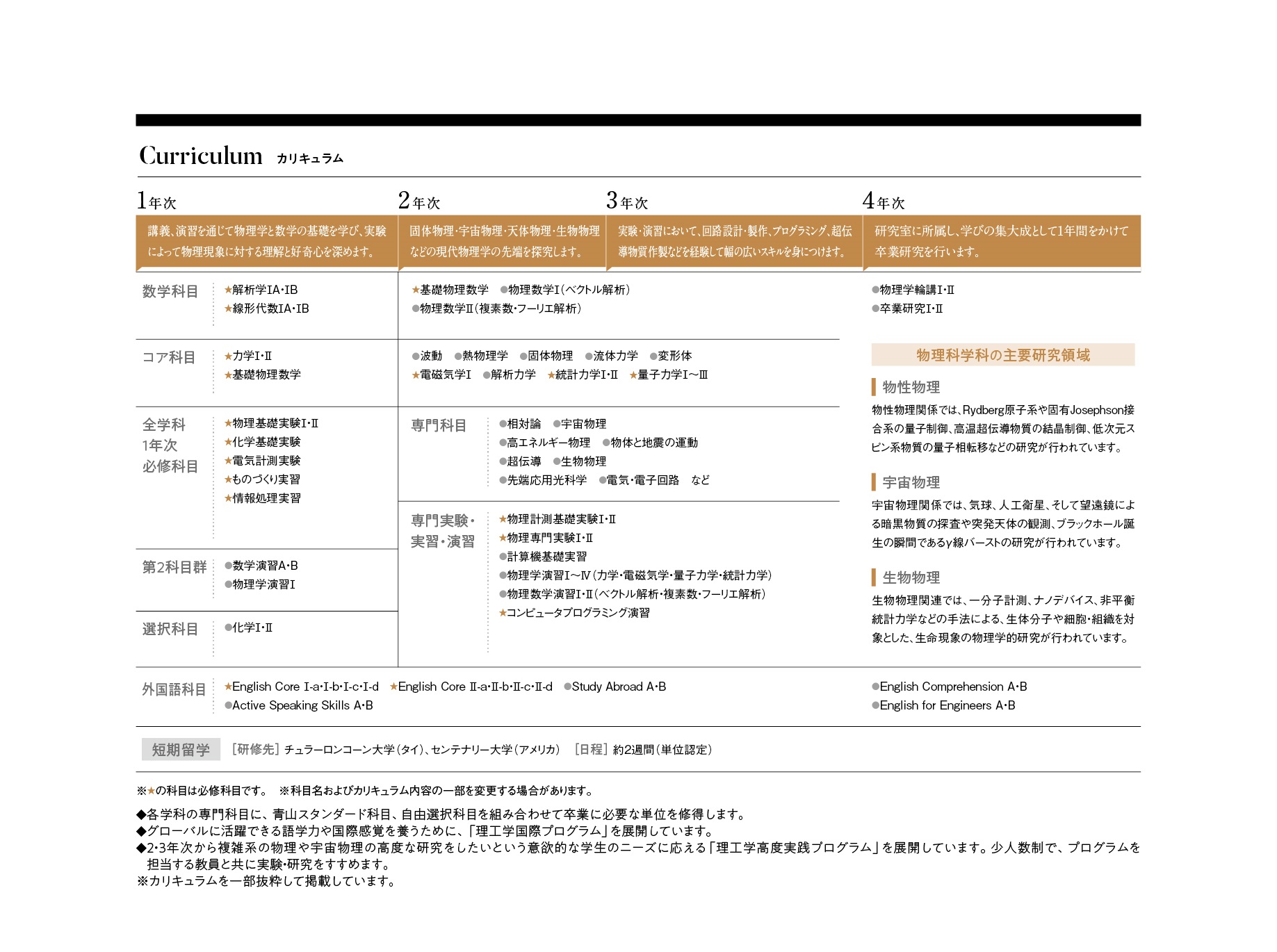- 2025年度 授業要覧 理工学部
学びの特色とカリキュラム(物理科学科)
※ここで紹介する履修モデルは、あくまでも一例です。
COURSE FEATURES 主要科目の特長
物理科学科
| 科目名 | 特長 |
|---|---|
|
量子力学
|
現代物理学の柱の一つであり、新しい科学技術の創造に必要不可欠である量子力学の理解と修得を目的とする。講義の内容は量子力学の基礎のみならず数多くの応用を扱い、様々な自然現象の説明にまで至る。
|
|
統計力学
|
統計力学はミクロの世界とマクロの世界をつなぐ物理学である。講義では物質の原子・分子レベルの微視的構造からその巨視的性質までを、統計的な考え方を導入することで統一的な観点から論ずる。
|
|
宇宙物理
|
不思議にみちあふれる宇宙天体現象を物理の手法を用いて理解を試みる。恒星の誕生・進化、超新星爆発、コンパクト星など主題材として扱い、これらの天体の物理をどのように観測から導き出すか、その観測手法についても論じる。
|
|
固体物理
|
金属や半導体、絶縁体について、電子運動や分布に起因してそれらに発現する様々な物理的性質を取り扱う。本講義では固体物理の基礎となる重要な概念の理解をめざした後、さらに超伝導の物理の概要を議論する。
|
理工学部共通
| 科目名 | 特長 |
|---|---|
|
English CoreⅠ-a
|
主に英語のリーディング力並びにリスニング力向上を目指す。リーディング力としては、日常的に非常によく使用される表現で書かれた比較的短く簡潔なテキストを読み、内容を理解することができる力の獲得を目指す。また、リスニング力としては、はっきりとゆっくりとした発話・発音であれば、具体的な必要性を満たすことができる程度に理解できる力を養成する。
|
|
English CoreⅠ-b
|
英語の読解力と作文力を伸ばすことを目的とする。文章構成を理解し、内容を正確に読み取り、要約する力を養っていく。特に筆者の姿勢や視点が出ている記事や報告文が正確に読めるようになることを目標とする。また、関心ある話題についてつながりのあるテクストが書ける力を高めていく。正確な読解力・作文力のために、語彙・文法・句読法も取り上げる。
|
|
English CoreⅠ-c
|
英語のリスニングとスピーキング力を伸ばすことを目的とする。ゆっくりと明瞭に話された言葉を理解し、自分自身や自分の家族・学校・地域などの身の回りの事柄に関連した句や表現が把握できる力を養っていく。また、簡単な英語で意見や気持ちを伝達し、賛成や反対などの意見を表現し、類似点や相違点を表すことができるようになることを目指す
|
|
English CoreⅠ-d
|
趣味や好き嫌いについて複数の文を用いて、簡単な語や基礎的な表現を使って書いたり、話したりすることができる。自分の経験について辞書を用いて、短い文章を書いたり、話したりすることができる。前もって発話することを用意した上で、日常生活に関する簡単な事実を、簡単な語や基礎的な句を限られた構文を用い、複数の文で描写できる。
|


